Key takeaways:
- Urban sketching fosters mindfulness and creativity, allowing artists to observe and connect deeply with their surroundings.
- Essential tools include a lightweight sketchbook, fine-tipped pens, and a compact watercolor set to enhance the sketching experience.
- Sharing sketches not only showcases art but also creates opportunities for connection and community, enriching the artist’s journey.
- Drawing from personal experiences in urban settings enables artists to document their lives and express emotions through their art.
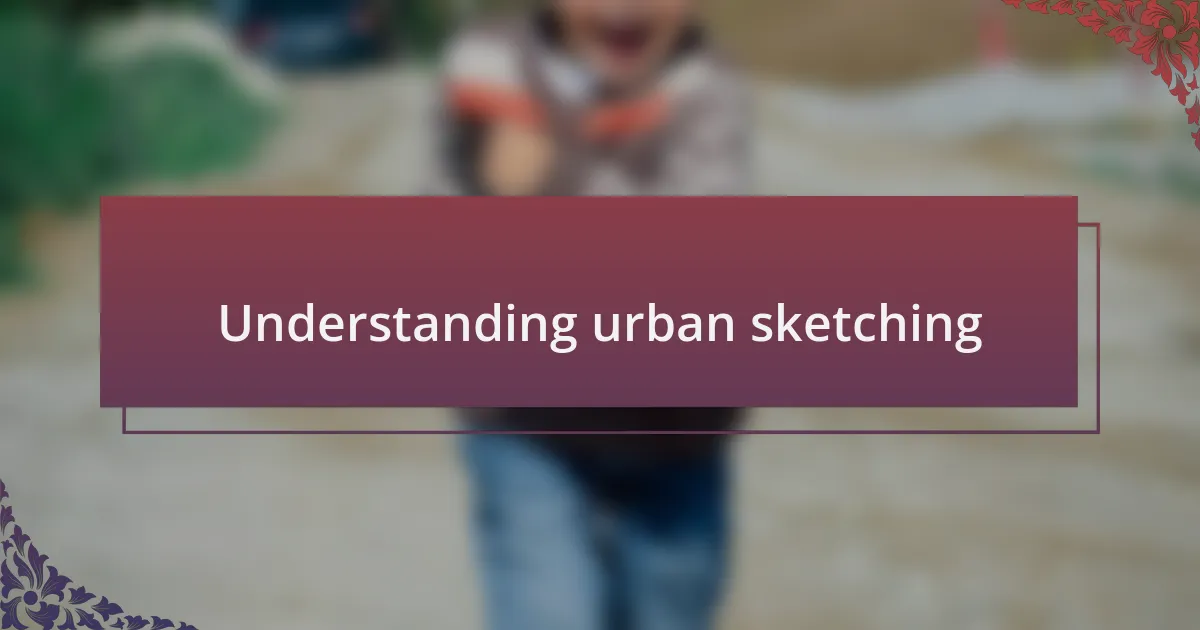
Understanding urban sketching
Urban sketching is a spontaneous and delightful way to capture the world around you, where every sketch invites you to slow down and really see. I remember my first attempt on a bustling street; I felt nervous but excited. What details would stand out? The laughter of kids playing, the aroma of street food wafting by—it all became part of my canvas.
The beauty of urban sketching lies in its freedom. There are no strict rules or expectations; it’s all about observing and expressing your unique perspective. I once sketched an old man reading a newspaper at a park bench. It wasn’t just a drawing; it was a snapshot of life, filled with stories waiting to be told. Have you ever felt that urge to put your feelings onto paper?
Every line you draw is an opportunity to reflect on your surroundings and share your thoughts with others. This art form transcends mere representation; it conveys emotion and atmosphere. While sketching a vibrant downtown market, I felt a connection with every passerby, merging my experience with theirs. Isn’t it fascinating how art can create such bonds, even in a busy city?
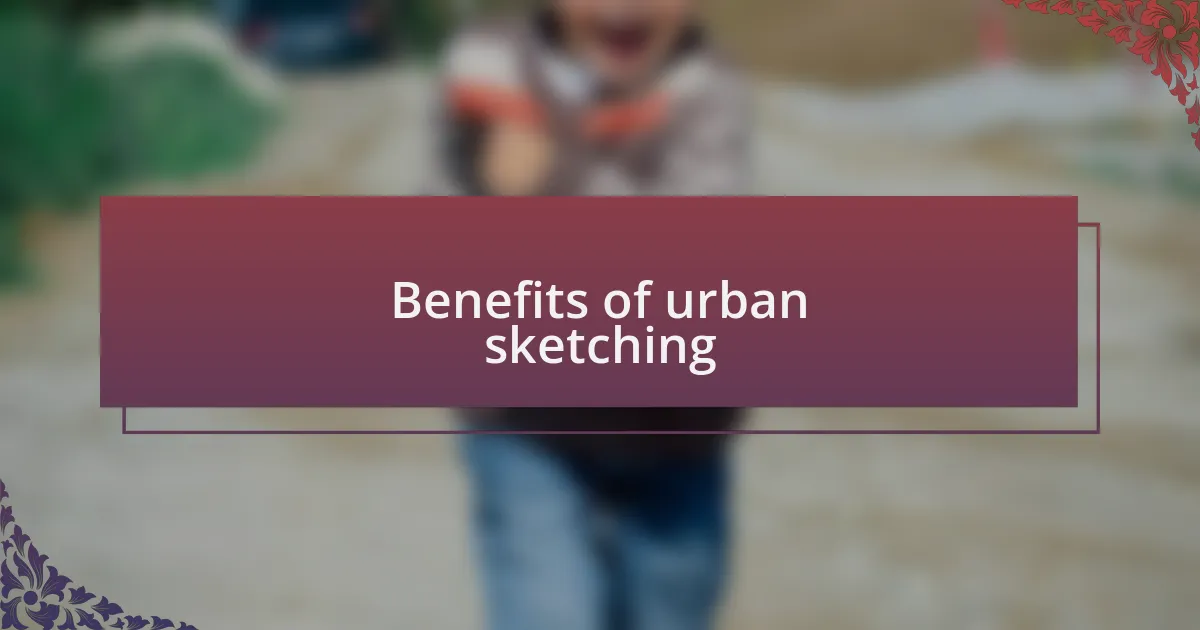
Benefits of urban sketching
Urban sketching offers several emotional and cognitive benefits. When I sketch, I feel a heightened sense of awareness about my environment. While capturing the details of a bustling street or a quiet corner, I often discover aspects I previously overlooked. It’s like gently peeling back layers from my surroundings and appreciating the nuances that define a place.
Moreover, urban sketching can be a powerful tool for mindfulness. I remember immersing myself in a sketch of a local café. The sounds of swirling coffee, animated conversations, and clinking cups wrapped around me as I drew. In that moment, all distractions faded away, and the act of sketching became a form of meditation. Have you ever found that kind of peace in a seemingly chaotic world?
Another notable benefit is the sense of community that comes with it. I often join local sketching groups, where exchanging ideas and experiences feels invigorating. I recall attending a sketch walk where smiles and encouragement flowed freely among participants. Each shared sketch became a testament to our unique perspectives. Embracing the diversity in styles and stories reminded me that while we all see the world differently, our passion for art binds us together.
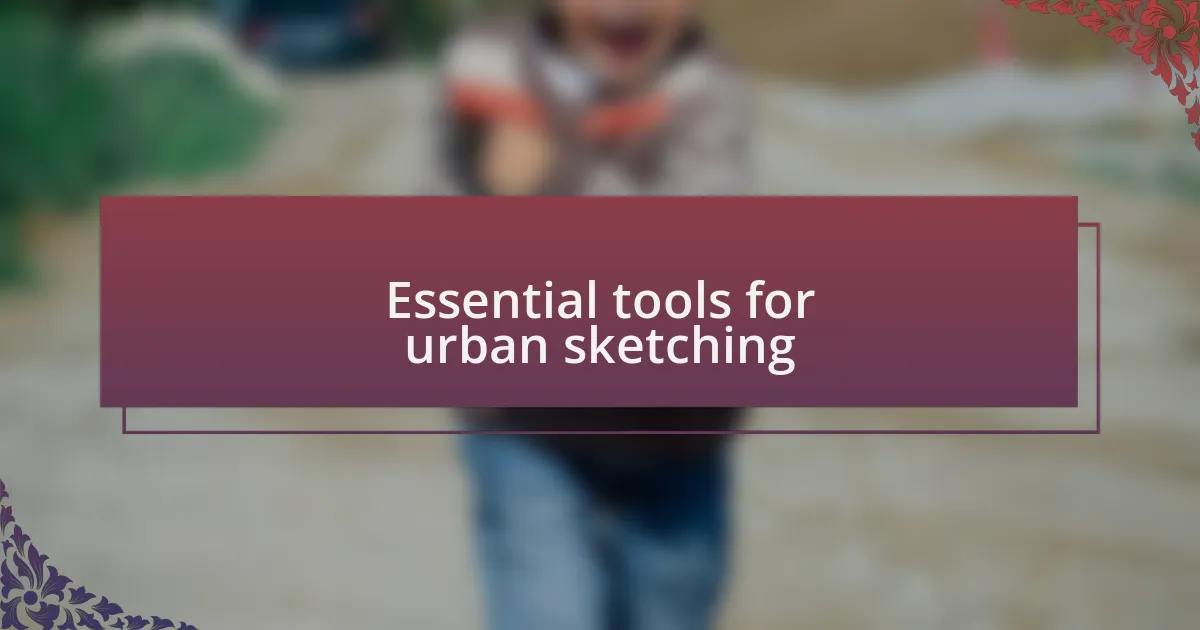
Essential tools for urban sketching
When it comes to urban sketching, having the right tools can truly enhance the experience. My go-to essentials include a lightweight sketchbook that easily fits in my bag, allowing me to capture spontaneous moments anywhere I go. I often opt for a sketchbook with thicker pages, which can handle various mediums and prevent ink from bleeding through, ensuring my sketches remain vibrant and intact.
I also find that a good set of pens is crucial for capturing the intricate details of a scene. My favorites are fine-tipped pens that offer precision, creating crisp lines that bring my sketches to life. Have you ever tried a brush pen? I recall the first time I used one; it was like dancing across the page, allowing me to add expressive strokes that conveyed more than just outlines. The versatility of these pens means I can switch between delicate lines and bold accents, depending on my creative mood.
Finally, my color palette is essential; I typically carry a compact watercolor set. The joy of adding splashes of color to my sketches always creates a sense of excitement. I vividly remember painting a sunset over the city skyline, where the hues transformed my sketch into a warm, glowing representation of that moment. What tools do you think would inspire your creativity while sketching? I believe that finding the right combination can make all the difference in your personal artistic journey.
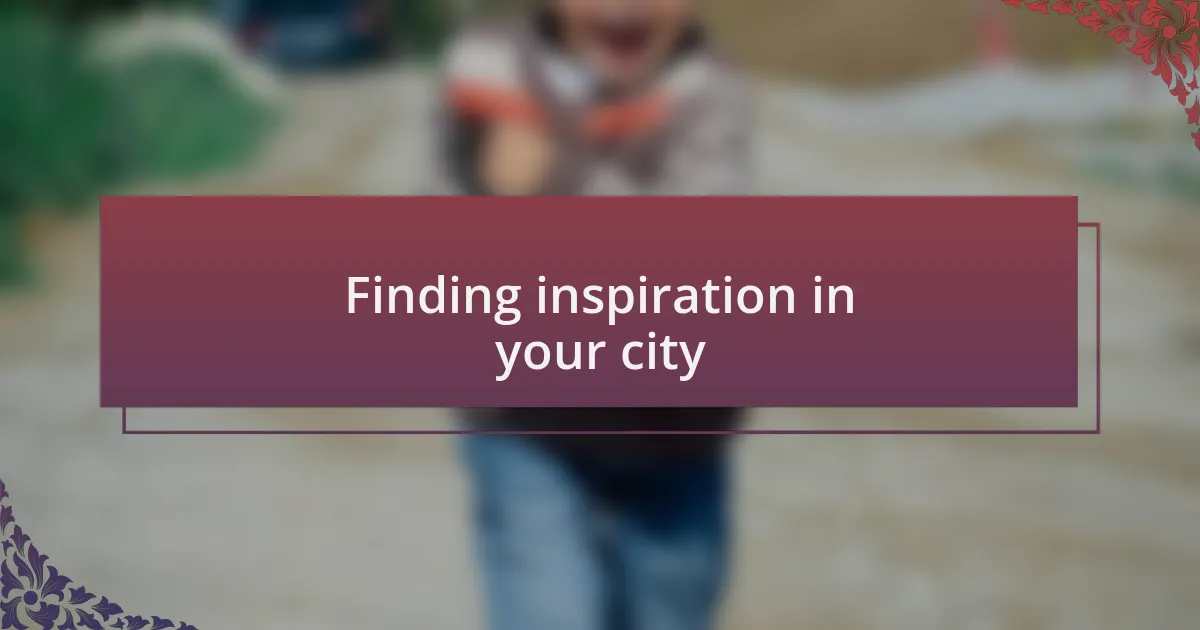
Finding inspiration in your city
As I wander through the streets of my city, I’m constantly amazed by how inspiration can strike in the most unexpected places. One afternoon, while resting at a bustling café, I noticed the dynamic interplay between light and shadow on the faces of passersby. That moment became the foundation for an entire series of sketches, each capturing a fleeting emotion I had observed. Have you ever felt that rush of creativity when you least expect it?
Parks, alleyways, and rooftops are often my favorite spots for sketching, as they reveal the hidden stories of urban life. Just last week, I found myself sketching in a quiet corner of a local park, where children played and laughter filled the air. The vibrant energy around me fueled my creativity, and I couldn’t help but reflect on how the joy of simple moments can lead to powerful artistic expressions. Have you explored your city’s parks for inspiration recently?
Sometimes, it’s not just the scenery that ignites my artistic impulse, but also the people I encounter. I vividly recall a day spent capturing a street musician pouring their heart into a soulful melody. The depth of their passion resonated within me, prompting me to experiment with bolder strokes and colors in my sketch. It made me wonder—how often do we overlook the inspiring stories that walk among us? Embracing these encounters can truly elevate our urban sketching adventures.
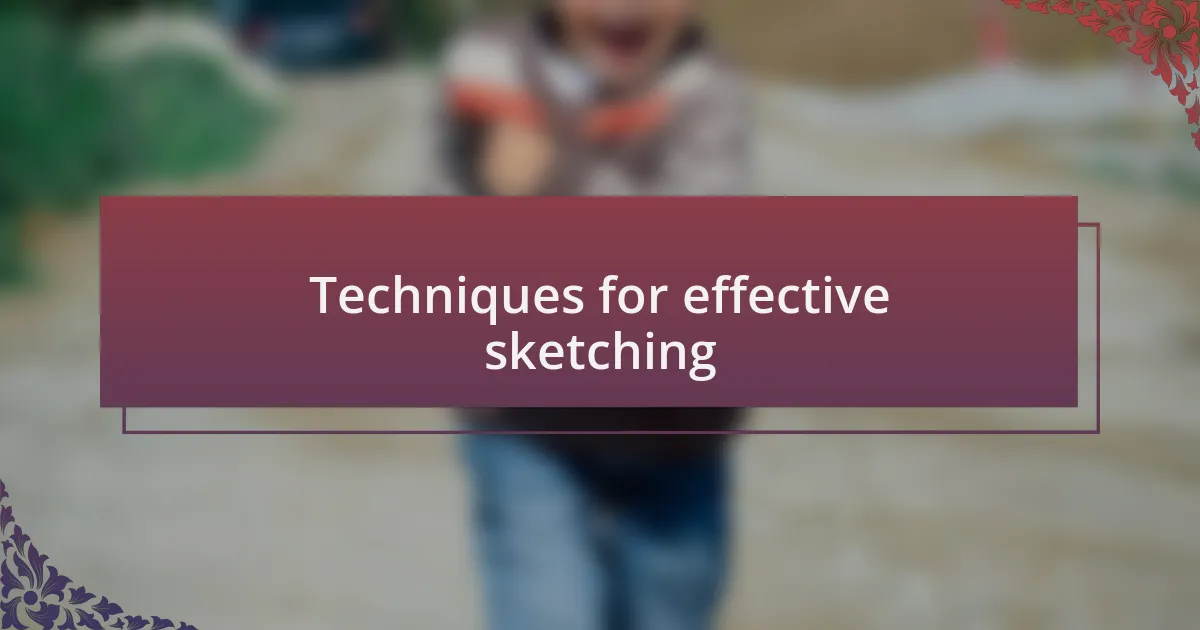
Techniques for effective sketching
When I pick up my sketchbook, I often start with quick gestures to capture the essence of a scene, focusing on basic shapes rather than details. This technique, known as “gesture drawing,” helps me connect with the rhythm and energy of my surroundings. Have you ever noticed how a few lines can encapsulate the movement of people or the stillness of an urban setting?
As I sketch, I also find that varying my line weight can add depth and character to my work. For instance, using a heavier line for the outlines of a building while employing lighter strokes for the background creates a compelling contrast. It’s fascinating how a simple shift in pressure can evoke different feelings in a drawing—doesn’t that make you want to experiment with your tools?
Additionally, I often like to incorporate color to enhance my sketches. The vibrant hues of the city can transform a mundane scene into something extraordinary. Recently, I added splashes of watercolor while sitting beside a busy intersection, and the bright colors brought the chaos of the moment to life on paper. Isn’t it interesting how a few well-placed colors can evoke emotions and transport the viewer right back to that bustling energy?

Personal experiences with urban sketching
There was a day when I decided to sketch at a local park. As I watched families enjoying their time together, I felt a deep connection to the simplicity of joy that these moments brought. It struck me how capturing an innocent smile or the playful movement of children could encapsulate the warmth of community—have you ever felt that pulse of life in your sketches?
One of my favorite experiences happened while I was sketching a street musician playing by the sidewalk. As I concentrated on translating his passion onto paper, I realized I was also immersing myself in his world. It was almost as if time stood still; I could feel the vibrations of his music resonate within me. Isn’t it powerful how art can bridge connections between strangers?
Sometimes, urban sketching feels like a way to document my city—a visual diary of sorts. I remember sketching a sunset behind a skyline while reflecting on my own journey. Each stroke told a story not only of the vibrant colors before me but also of my personal growth and experiences. Can a simple drawing really capture the essence of our life’s journey? I believe it can, and that keeps me coming back to the sketchbook time and time again.
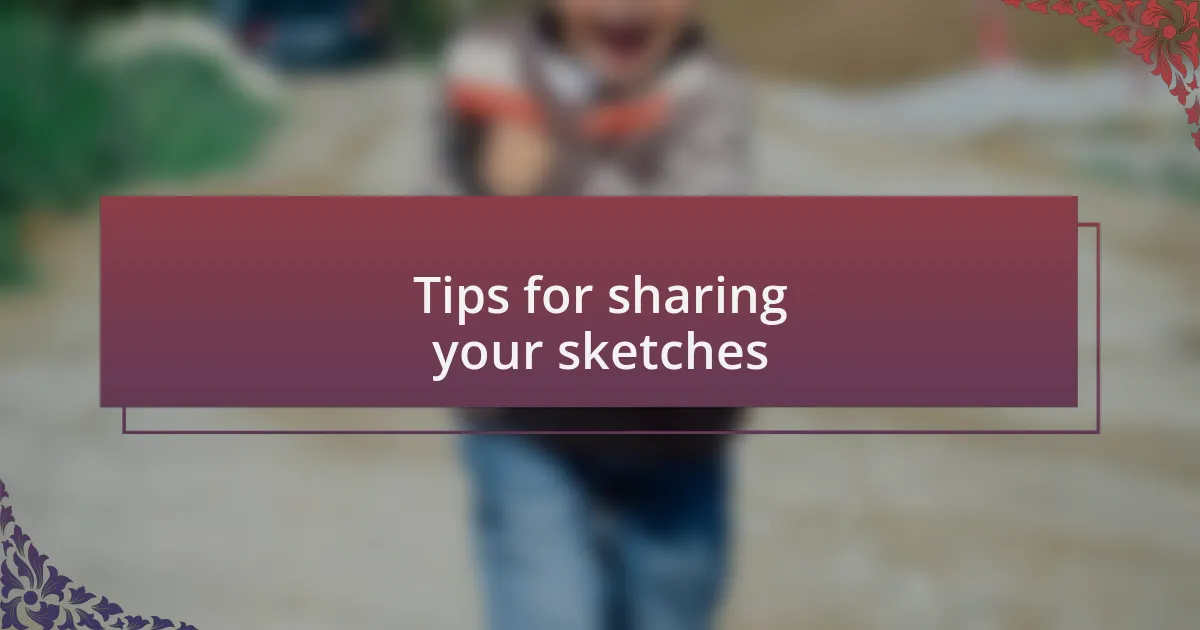
Tips for sharing your sketches
Sharing your sketches is not just about showcasing your art; it’s an opportunity to connect with others. I remember posting a simple sketch of a rainy street to social media. The comments from fellow artists about their similar experiences inspired me in ways I hadn’t expected. Have you ever thought about how your work can resonate with someone else’s story?
When sharing your sketches, consider the story behind each piece. For instance, I sketched a crowded café during an indie film festival. I took a moment to explain how the atmosphere buzzed with creativity, a detail that brought my audience into that moment with me. How can your sketches tell more than just what’s on the page?
Experiment with different platforms for sharing your work. I once joined an urban sketching group online, and it was incredible to see how my sketches evolved with feedback from peers. Have you explored online communities or even local meet-ups? Engaging with others can foster growth and deepen your passion for urban sketching.